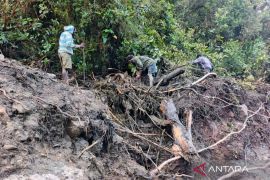According to the Meteorology, Climatology and Geophysics Agency (BMKG), about 43.8 percent of Indonesia has entered the rainy season, which is expected to peak gradually between November 2025 and January 2026.
The agency warned that increased rainfall could trigger hydrometeorological disasters such as floods and landslides.
BMKG also forecast that a weak La Niña phenomenon will develop in November and continue through February 2026.
“Although La Niña is predicted to be weak, we must remain vigilant because it can still heighten disaster risks,” Listyo said on Wednesday.
To strengthen preparedness, Listyo outlined eight key directives. The first is to conduct early detection and mapping of vulnerable areas in coordination with BMKG and other agencies.
Related news: National Police vow to protect Indonesians from natural disasters
The second is to provide public information and maintain security in areas facing potential threats.
Other measures include ensuring personnel readiness, improving infrastructure and evacuation equipment, and maintaining logistics and operational vehicles.
Police units are also instructed to hold regular disaster response drills and training sessions.
Listyo emphasized the importance of speed and accuracy in emergency operations—from evacuation and aid delivery to trauma recovery—to restore infrastructure and community livelihoods quickly.
He also urged officers to perform humanitarian duties “with empathy, humanity, and professionalism” to ensure public safety and comfort.
He called for strict adherence to disaster management procedures before, during, and after emergencies, with ongoing evaluation to boost resilience.
Coordination will also be intensified with the military, disaster and rescue agencies, local governments, volunteers, and communities to strengthen nationwide response capacity, he added.
Related news: Indonesia readies 5,755 heavy machines to prepare for rainy season
Translator: Resinta Sulistiyandari
Editor: Rahmad Nasution
Copyright © ANTARA 2025












